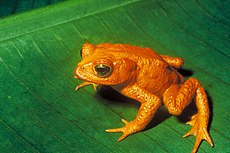Conservation status
| Conservation status | |
|---|---|
 |
|
| Extinct | |
| Threatened | |
| Lower Risk | |
|
Other categories |
|
|
|
|
Related topics |
|

|
|
The conservation status of a group of organisms (for instance, a species) indicates whether the group still exists and how likely the group is to become extinct in the near future. Many factors are taken into account when assessing conservation status: not simply the number of individuals remaining, but the overall increase or decrease in the population over time, breeding success rates, and known threats. Various systems of conservation status exist and are in use at international, multi-country, national and local levels as well as for consumer use.
The IUCN Red List of Threatened Species is the best known worldwide conservation status listing and ranking system. Species are classified by the IUCN Red List into nine groups set through criteria such as rate of decline, population size, area of geographic distribution, and degree of population and distribution fragmentation.
Also included are species that have gone extinct since 500 AD. When discussing the IUCN Red List, the official term "threatened" is a grouping of three categories: critically endangered, endangered, and vulnerable.
The Convention on International Trade in Endangered Species of Wild Fauna and Flora (CITES) aims to ensure that international trade in specimens of wild animals and plants does not threaten their survival. Many countries require CITES permits when importing plants and animals listed on CITES.
In the European Union (EU), the Birds and Habitats Directives are the legal instruments that evaluate the conservation status within the EU of species and habitats.
NatureServe conservation status focuses on Latin America, United States, Canada, and the Caribbean. It has been developed by scientists from NatureServe, The Nature Conservancy, and the network of natural heritage programs and data centers. It is increasingly integrated with the IUCN Red List system. Its categories for species include: presumed extinct (GX), possibly extinct (GH), critically imperiled (G1), imperiled (G2), vulnerable (G3), apparently secure (G4), and secure (G5). The system also allows ambiguous or uncertain ranks including inexact numeric ranks (e.g. G2?), and range ranks (e.g. G2G3) for when the exact rank is uncertain. NatureServe adds a qualifier for captive or cultivated only (C), which has a similar meaning to the IUCN Red List extinct in the wild (EW) status.
...
Wikipedia
